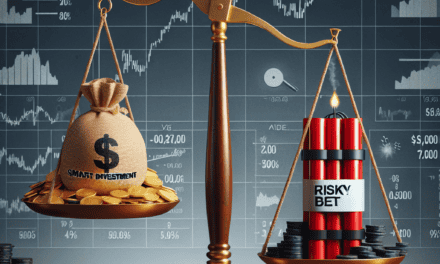“Market Rally Stalls: Buyer Momentum Hits the Brakes”
Introduction
In recent trading sessions, the market rally that had been gaining traction has shown signs of losing steam as buyer momentum begins to wane. After a period of robust gains fueled by investor optimism and favorable economic indicators, the upward trajectory has encountered resistance, leading to a stall in the rally. This shift in market dynamics is attributed to a confluence of factors, including profit-taking by investors, emerging concerns over economic growth prospects, and geopolitical uncertainties. As a result, market participants are adopting a more cautious stance, reassessing their strategies in light of the evolving financial landscape. The fading momentum underscores the inherent volatility and unpredictability of financial markets, prompting analysts and investors alike to closely monitor upcoming economic data releases and policy decisions that could influence future market direction.
Understanding Market Rally Stalls: Key Indicators and Causes
In the ever-evolving landscape of financial markets, the phenomenon of a market rally stalling is a subject of considerable interest to investors and analysts alike. A market rally, characterized by a sustained increase in asset prices, often generates optimism and attracts a wave of buyers eager to capitalize on upward momentum. However, when this momentum begins to fade, it signals a potential shift in market dynamics that warrants closer examination. Understanding the key indicators and causes of a market rally stall is crucial for investors seeking to navigate these complex waters.
One of the primary indicators of a market rally stalling is a noticeable decline in trading volume. During a robust rally, increased trading activity typically accompanies rising prices, as more participants enter the market to take advantage of the upward trend. However, when trading volume begins to diminish, it suggests that the enthusiasm driving the rally may be waning. This reduction in volume can indicate that fewer investors are willing to buy at elevated prices, potentially leading to a plateau or reversal in the market’s trajectory.
In addition to declining volume, another critical indicator of a stalling rally is the emergence of resistance levels. Resistance levels are price points at which an asset struggles to move higher, often due to an abundance of sell orders. When a market rally encounters such resistance, it can signal that the upward momentum is losing steam. This resistance may arise from profit-taking by investors who bought at lower prices or from a broader market sentiment that prices have reached unsustainable levels.
Moreover, shifts in macroeconomic factors can also contribute to a market rally stalling. Economic indicators such as interest rates, inflation, and employment data play a significant role in shaping investor sentiment. For instance, if central banks signal an intention to raise interest rates to combat inflation, it can dampen investor enthusiasm, as higher borrowing costs may lead to reduced corporate profits and consumer spending. Consequently, the anticipation of tighter monetary policy can act as a headwind for a rally, causing it to stall.
Furthermore, geopolitical events and uncertainties can exert a profound influence on market dynamics. Political instability, trade tensions, or unexpected global events can introduce a level of uncertainty that prompts investors to reassess their risk exposure. In such scenarios, the initial optimism driving a rally may give way to caution, as market participants seek to protect their portfolios from potential volatility. This shift in sentiment can contribute to a stall in the rally, as buyers become more hesitant to commit capital.
In addition to these factors, technical analysis can provide valuable insights into the potential stalling of a market rally. Chart patterns, such as double tops or head and shoulders formations, can indicate a weakening trend and foreshadow a reversal. Technical analysts closely monitor these patterns, along with moving averages and other indicators, to assess the strength of a rally and identify potential turning points.
In conclusion, a market rally stalling is a multifaceted phenomenon influenced by a combination of declining trading volume, resistance levels, macroeconomic shifts, geopolitical uncertainties, and technical indicators. By understanding these key indicators and causes, investors can better anticipate potential changes in market dynamics and make informed decisions. As markets continue to evolve, maintaining a keen awareness of these factors will be essential for navigating the complexities of financial markets and optimizing investment strategies.
The Role of Buyer Momentum in Sustaining Market Rallies
In the intricate world of financial markets, the concept of buyer momentum plays a pivotal role in sustaining market rallies. This momentum, often driven by investor sentiment and market psychology, can significantly influence the trajectory of asset prices. However, when this momentum begins to fade, as observed in recent market activities, it can lead to a stall in the rally, prompting investors and analysts to reassess their strategies and expectations.
Buyer momentum is essentially the force that propels asset prices upward, fueled by a collective optimism among investors. This optimism can stem from various factors, including positive economic indicators, corporate earnings reports, or geopolitical stability. When investors perceive these factors as favorable, they are more likely to buy assets, thereby driving up prices. This creates a self-reinforcing cycle where rising prices attract more buyers, further boosting the market.
However, sustaining this momentum requires continuous positive reinforcement. In the absence of new catalysts or if existing factors lose their luster, the momentum can wane. This is particularly evident when market participants begin to question the sustainability of the rally, leading to a shift in sentiment. As a result, the once-robust buying activity may diminish, causing the market to stall.
The recent market rally, which initially showed promising signs of growth, has encountered such a stall. Several factors have contributed to this shift in momentum. For instance, economic data that initially appeared robust may have shown signs of slowing down, causing investors to reassess their positions. Additionally, geopolitical tensions or unexpected policy changes can introduce uncertainty, prompting a more cautious approach among market participants.
Moreover, the role of institutional investors cannot be overlooked in this context. These large players often have the power to sway market trends significantly. When they perceive a potential stall in the rally, they may adjust their portfolios accordingly, either by taking profits or reallocating assets to safer investments. This behavior can exacerbate the fading momentum, as other investors may follow suit, leading to a broader market impact.
Furthermore, the influence of technological advancements and algorithmic trading has added another layer of complexity to market dynamics. These systems, designed to capitalize on short-term price movements, can amplify the effects of fading momentum. As algorithms detect shifts in buying patterns, they may trigger automated sell-offs, further contributing to the stall.
In light of these developments, it becomes crucial for investors to remain vigilant and adaptable. Understanding the underlying factors that drive buyer momentum and recognizing the signs of its potential fade can provide valuable insights for making informed investment decisions. Diversification and risk management strategies become even more essential in navigating such uncertain market conditions.
In conclusion, while buyer momentum is a critical component in sustaining market rallies, its transient nature means that investors must be prepared for potential stalls. By staying informed and responsive to changing market dynamics, investors can better position themselves to weather the challenges posed by fading momentum. As the market continues to evolve, maintaining a balanced perspective and a strategic approach will be key to navigating the complexities of financial markets.
Analyzing the Impact of Fading Buyer Momentum on Stock Prices
The recent market rally, which had invigorated investors with hopes of sustained growth, has encountered a significant slowdown as buyer momentum begins to wane. This shift in market dynamics has prompted analysts and investors alike to reassess their strategies and expectations. Understanding the implications of this fading momentum is crucial for stakeholders aiming to navigate the complexities of the stock market effectively.
Initially, the rally was fueled by a confluence of factors, including robust corporate earnings, favorable economic indicators, and a general sense of optimism about the global economic recovery. Investors, buoyed by these positive signals, poured capital into equities, driving stock prices to new heights. However, as the rally progressed, several underlying issues began to surface, gradually eroding the enthusiasm that had characterized the market’s upward trajectory.
One of the primary factors contributing to the stall in the rally is the growing concern over inflationary pressures. As inflation rates have risen, central banks around the world have signaled potential interest rate hikes to curb these pressures. This prospect has introduced a degree of uncertainty into the market, as higher interest rates could dampen economic growth and, consequently, corporate profitability. Investors, wary of these potential headwinds, have become more cautious, leading to a reduction in buying activity.
Moreover, geopolitical tensions have also played a role in tempering buyer enthusiasm. Ongoing conflicts and trade disputes have injected volatility into the market, causing investors to adopt a more risk-averse stance. The uncertainty surrounding these geopolitical issues has made it challenging for investors to predict market movements accurately, further contributing to the slowdown in buying momentum.
In addition to these external factors, internal market dynamics have also influenced the current situation. As stock prices soared during the rally, valuations reached levels that some analysts deemed unsustainable. This has led to concerns about potential market corrections, prompting investors to reassess their positions and, in some cases, take profits. The resulting sell-off has added downward pressure on stock prices, exacerbating the stall in the rally.
Furthermore, the fading momentum can be attributed to a shift in investor sentiment. The initial euphoria that accompanied the rally has given way to a more measured and cautious outlook. Investors are now more focused on the fundamentals, scrutinizing corporate earnings reports and economic data with greater intensity. This shift in focus has led to a more selective approach to investing, with market participants favoring stocks with strong fundamentals over those driven primarily by speculative fervor.
As the market rally stalls, the impact on stock prices is becoming increasingly evident. The reduced buying activity has led to increased volatility, with stock prices experiencing more frequent fluctuations. This environment presents both challenges and opportunities for investors. On one hand, the heightened volatility can lead to potential losses for those caught on the wrong side of market movements. On the other hand, it also presents opportunities for astute investors to capitalize on price dislocations and identify undervalued stocks.
In conclusion, the stalling of the market rally due to fading buyer momentum underscores the importance of understanding the multifaceted factors influencing stock prices. As investors navigate this complex landscape, a focus on fundamentals, coupled with a keen awareness of external and internal market dynamics, will be essential in making informed investment decisions. While the current environment presents challenges, it also offers opportunities for those willing to adapt and respond to the evolving market conditions.
Strategies for Investors When Market Rallies Lose Steam

As the market rally stalls and buyer momentum fades, investors find themselves at a crossroads, contemplating the best strategies to navigate this period of uncertainty. Understanding the dynamics that lead to a slowdown in market rallies is crucial for making informed decisions. Typically, market rallies are driven by a combination of positive economic indicators, strong corporate earnings, and investor optimism. However, when these factors begin to wane, it is essential for investors to reassess their strategies to protect their portfolios and capitalize on potential opportunities.
One of the first steps investors should consider is re-evaluating their asset allocation. During a market rally, portfolios may become skewed towards equities due to rising stock prices. As the rally loses steam, it may be prudent to rebalance the portfolio to ensure a diversified mix of assets. This could involve increasing exposure to bonds or other fixed-income securities, which tend to be less volatile and can provide a buffer against market downturns. Additionally, incorporating alternative investments such as real estate or commodities can further enhance diversification and reduce risk.
Moreover, investors should pay close attention to the underlying fundamentals of their investments. In a slowing market, companies with strong balance sheets, consistent cash flow, and competitive advantages are more likely to weather economic headwinds. Conducting a thorough analysis of individual stocks and sectors can help identify those that are well-positioned to perform even in challenging conditions. This approach not only mitigates risk but also uncovers potential opportunities for growth.
Another strategy to consider is the implementation of defensive investment tactics. This might include increasing allocations to sectors that are traditionally more resilient during economic slowdowns, such as consumer staples, healthcare, and utilities. These sectors tend to have stable demand regardless of economic conditions, providing a degree of safety for investors. Additionally, focusing on dividend-paying stocks can offer a steady income stream, which can be particularly valuable when capital appreciation is limited.
Furthermore, maintaining a long-term perspective is essential when market rallies lose momentum. Short-term volatility can be unsettling, but it is important to remember that markets have historically trended upwards over the long run. Investors who remain patient and committed to their investment goals are often rewarded for their perseverance. This does not mean ignoring market signals altogether; rather, it involves making calculated adjustments while keeping the broader investment horizon in mind.
In addition to these strategies, staying informed about macroeconomic trends and geopolitical developments is crucial. Economic indicators such as interest rates, inflation, and employment figures can provide valuable insights into the market’s direction. Similarly, geopolitical events can have significant implications for global markets. By staying abreast of these factors, investors can make more informed decisions and adjust their strategies accordingly.
Finally, consulting with financial advisors or investment professionals can provide additional guidance during periods of market uncertainty. These experts can offer personalized advice based on an individual’s risk tolerance, financial goals, and current market conditions. Their insights can be invaluable in crafting a strategy that aligns with both short-term needs and long-term objectives.
In conclusion, when market rallies stall and buyer momentum fades, investors must adopt a proactive approach to safeguard their portfolios and seize potential opportunities. By re-evaluating asset allocation, focusing on fundamentals, implementing defensive tactics, maintaining a long-term perspective, staying informed, and seeking professional advice, investors can navigate these challenging times with confidence and poise.
Historical Examples of Market Rallies Stalling and Lessons Learned
Throughout history, financial markets have experienced numerous rallies that, despite initial enthusiasm, eventually stalled as buyer momentum faded. These instances provide valuable lessons for investors and analysts seeking to understand the dynamics of market behavior. By examining historical examples, we can glean insights into the factors that contribute to the cessation of market rallies and the implications for future investment strategies.
One notable example of a market rally stalling occurred during the dot-com bubble of the late 1990s and early 2000s. Initially fueled by the rapid growth of internet-based companies, the market experienced a surge in stock prices as investors eagerly sought to capitalize on the burgeoning digital economy. However, as the rally progressed, it became increasingly evident that many of these companies were overvalued, lacking sustainable business models or profitability. Consequently, buyer momentum waned, leading to a dramatic market correction. This episode underscores the importance of evaluating the intrinsic value of investments and exercising caution in the face of speculative exuberance.
Similarly, the housing market rally in the mid-2000s serves as a cautionary tale of momentum stalling. Driven by low interest rates and lax lending standards, the housing market experienced a significant upswing, with home prices soaring to unprecedented levels. However, as the rally continued, underlying weaknesses in the financial system, such as the proliferation of subprime mortgages, began to surface. The subsequent decline in buyer confidence precipitated a collapse in housing prices, triggering a global financial crisis. This example highlights the necessity of scrutinizing the structural underpinnings of market rallies and recognizing the potential for systemic risks.
In addition to these well-documented cases, the Japanese asset price bubble of the late 1980s offers further insights into the dynamics of market rallies stalling. During this period, Japan’s stock and real estate markets experienced rapid appreciation, driven by speculative investment and excessive credit expansion. However, as asset prices reached unsustainable levels, the rally lost momentum, culminating in a prolonged period of economic stagnation known as the “Lost Decade.” This scenario illustrates the dangers of unchecked speculation and the long-term consequences of market corrections.
Transitioning to more recent history, the cryptocurrency market provides a contemporary example of a rally stalling. In late 2017, Bitcoin and other digital currencies experienced a meteoric rise in value, attracting significant attention from both retail and institutional investors. Yet, as regulatory concerns and questions about the viability of cryptocurrencies emerged, the rally lost steam, resulting in a sharp decline in prices. This case emphasizes the importance of regulatory clarity and the need for investors to remain vigilant in assessing the sustainability of emerging asset classes.
In conclusion, historical examples of market rallies stalling offer valuable lessons for investors and market participants. These instances underscore the importance of conducting thorough due diligence, recognizing the signs of speculative excess, and understanding the broader economic and regulatory context. By learning from past experiences, investors can better navigate the complexities of financial markets and make informed decisions that mitigate the risks associated with fading buyer momentum. As markets continue to evolve, these lessons remain pertinent, serving as a guide for future investment strategies and fostering a more resilient financial ecosystem.
How Economic Indicators Influence Buyer Momentum in Markets
The recent stall in the market rally has drawn attention to the intricate relationship between economic indicators and buyer momentum. Understanding this dynamic is crucial for investors seeking to navigate the complexities of financial markets. Economic indicators, which include metrics such as GDP growth rates, unemployment figures, and consumer confidence indices, serve as vital tools for assessing the health of an economy. These indicators provide insights into potential market movements, influencing investor sentiment and, consequently, buyer momentum.
Initially, a robust market rally often reflects positive economic indicators, suggesting a thriving economy. For instance, when GDP growth rates are high, it signals increased economic activity, which can boost corporate earnings and, in turn, stock prices. Similarly, low unemployment rates typically indicate a strong labor market, fostering consumer spending and business investment. These factors collectively contribute to heightened buyer momentum, as investors are more inclined to purchase assets in anticipation of continued economic prosperity.
However, the relationship between economic indicators and buyer momentum is not always straightforward. As markets are forward-looking, they often react not only to current data but also to expectations of future economic conditions. This can lead to situations where positive indicators are already priced into the market, causing rallies to stall when new data fails to exceed expectations. For example, if GDP growth meets but does not surpass forecasts, the market may experience a plateau as investors reassess their positions.
Moreover, the influence of economic indicators on buyer momentum can be affected by external factors such as geopolitical events, policy changes, and global economic trends. These elements can introduce uncertainty, prompting investors to adopt a more cautious approach. In such scenarios, even favorable economic indicators may not be sufficient to sustain a rally, as the overarching sentiment is tempered by concerns over potential risks.
Another critical aspect to consider is the role of central banks and their monetary policies. Interest rates, set by central banks, are a key economic indicator that can significantly impact buyer momentum. Lower interest rates generally encourage borrowing and investment, stimulating economic activity and supporting market rallies. Conversely, when central banks raise interest rates to combat inflation, borrowing costs increase, potentially dampening economic growth and curbing buyer momentum.
Furthermore, inflation itself is a pivotal economic indicator that can influence market dynamics. Moderate inflation is often seen as a sign of a healthy economy, but when inflation rates rise sharply, it can erode purchasing power and lead to increased costs for businesses. This scenario can create a challenging environment for markets, as investors weigh the potential impact on corporate profits and consumer spending.
In conclusion, the interplay between economic indicators and buyer momentum is a complex and multifaceted process. While positive indicators can drive market rallies, the sustainability of such movements depends on a range of factors, including investor expectations, external influences, and monetary policy decisions. As the recent stall in the market rally demonstrates, understanding these dynamics is essential for investors aiming to make informed decisions in an ever-evolving financial landscape. By closely monitoring economic indicators and considering their broader implications, investors can better anticipate shifts in buyer momentum and adjust their strategies accordingly.
Predicting Market Trends: What Happens When Buyer Momentum Fades?
In the ever-evolving landscape of financial markets, the dynamics of buyer momentum play a crucial role in shaping market trends. Recently, a noticeable stall in the market rally has raised questions about the sustainability of current trends and the potential implications for investors. Understanding the factors that contribute to the fading of buyer momentum is essential for predicting future market movements and making informed investment decisions.
Initially, market rallies are often driven by a confluence of positive economic indicators, investor optimism, and favorable market conditions. These factors collectively create a surge in buying activity, propelling asset prices upward. However, as the rally progresses, the initial enthusiasm can wane, leading to a deceleration in buyer momentum. This shift can be attributed to several interrelated factors that gradually erode the initial impetus.
One primary factor contributing to the fading of buyer momentum is the natural cycle of profit-taking. As asset prices rise, early investors may choose to lock in their gains, leading to increased selling pressure. This profit-taking behavior can create a self-reinforcing cycle, where the anticipation of further selling prompts additional investors to exit their positions, thereby dampening the upward momentum. Moreover, as prices reach elevated levels, the risk-reward ratio becomes less favorable, causing potential buyers to hesitate and adopt a more cautious approach.
In addition to profit-taking, external economic and geopolitical factors can also play a significant role in stalling a market rally. For instance, unexpected economic data releases, changes in monetary policy, or geopolitical tensions can introduce uncertainty and volatility into the market. Such developments can undermine investor confidence, prompting a reassessment of risk and a subsequent reduction in buying activity. As a result, the market may experience a period of consolidation or even a correction, as participants adjust their expectations in response to the evolving landscape.
Furthermore, the psychological aspect of market behavior cannot be overlooked. Investor sentiment, often influenced by media narratives and market speculation, can significantly impact buyer momentum. During a rally, positive sentiment can amplify buying activity, creating a feedback loop that sustains upward movement. However, when sentiment shifts due to negative news or a change in market perception, the resulting decline in confidence can lead to a rapid evaporation of buyer interest. This psychological shift can be particularly pronounced in markets characterized by high levels of speculation and leverage.
As buyer momentum fades, market participants must adapt their strategies to navigate the changing environment. For investors, this may involve reassessing their portfolios, diversifying their holdings, or adopting a more defensive stance to mitigate potential downside risks. Additionally, technical analysis can provide valuable insights into market trends, helping investors identify key support and resistance levels that may influence future price movements.
In conclusion, the stalling of a market rally due to fading buyer momentum is a complex phenomenon influenced by a myriad of factors, including profit-taking, external economic conditions, and investor sentiment. Understanding these dynamics is crucial for predicting market trends and making informed investment decisions. As the market landscape continues to evolve, investors must remain vigilant, adapting their strategies to align with the prevailing conditions and positioning themselves to capitalize on emerging opportunities. By doing so, they can navigate the challenges posed by shifting buyer momentum and enhance their prospects for long-term success in the financial markets.
Q&A
1. **What is a market rally?**
A market rally is a period during which stock prices rise significantly across a broad range of markets or sectors, often driven by positive investor sentiment or economic news.
2. **What causes a market rally to stall?**
A market rally can stall due to fading buyer momentum, which may occur when investors become cautious, economic indicators weaken, or external factors such as geopolitical tensions arise.
3. **What is buyer momentum?**
Buyer momentum refers to the strength and enthusiasm of investors purchasing stocks, which can drive prices higher during a rally.
4. **How can fading buyer momentum affect the market?**
Fading buyer momentum can lead to reduced trading volumes, slower price increases, or even a reversal in market trends as fewer investors are willing to buy at higher prices.
5. **What indicators suggest a market rally is stalling?**
Indicators include declining trading volumes, increased volatility, negative economic news, or technical analysis signals such as resistance levels being hit.
6. **What strategies might investors use when a rally stalls?**
Investors might adopt defensive strategies, such as shifting to more stable assets, diversifying portfolios, or using stop-loss orders to protect gains.
7. **What external factors can contribute to a stalling market rally?**
External factors include geopolitical events, changes in monetary policy, unexpected economic data, or corporate earnings reports that fall short of expectations.
Conclusion
The market rally has stalled as buyer momentum fades, indicating a potential shift in investor sentiment and market dynamics. This slowdown suggests that the initial enthusiasm driving the rally may be waning, possibly due to factors such as overvaluation concerns, economic uncertainties, or external geopolitical tensions. As buying pressure diminishes, the market could experience increased volatility and a potential correction, prompting investors to reassess their strategies and risk exposure. This pause in momentum underscores the importance of closely monitoring market indicators and economic data to gauge future market direction and investment opportunities.





